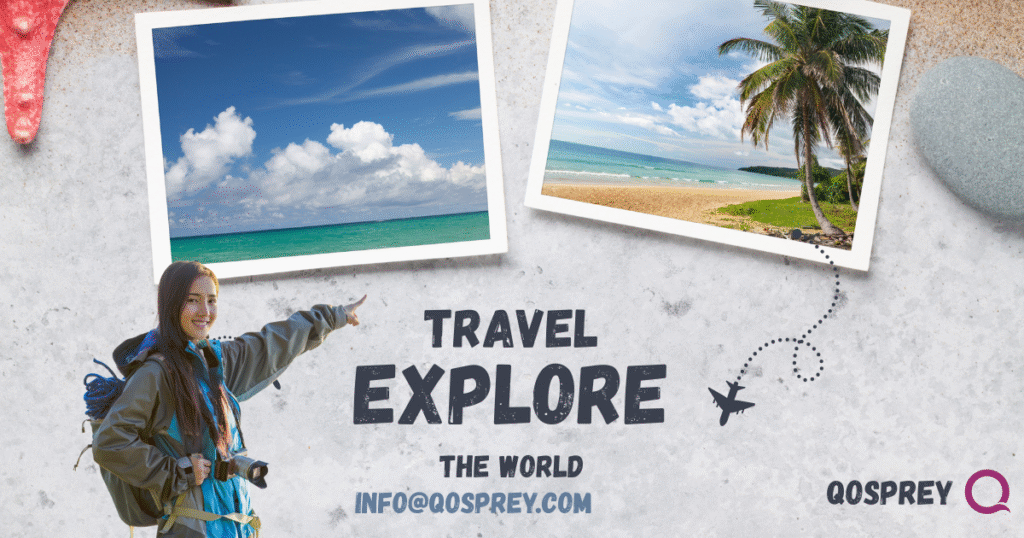Think about the last time you booked a trip. You didn’t walk to a local agent with a brochure in hand, right? Chances are, you opened your phone or laptop and started scrolling through travel websites. That’s exactly why a travel site today is not just a nice extra—it’s your business’s lifeline.
If your website looks old, slow, or confusing, people won’t waste their time. They’ll just move on to the next site. But when your design is clean, fast, and easy to use, visitors are much more likely to trust you with their booking. In this guide, I’ll walk you through the essentials of good travel website design, SEO tips, mistakes to avoid, and how Qosprey can help you pull it all together.
1. Why Travel Website Design Matters
First impressions online are brutal. Research shows around 75% of people judge a company’s trustworthiness based on its website. For a travel business, where customers are ready to spend hundreds or even thousands, that trust is everything.
A good design isn’t just pretty pictures—it’s the difference between someone hitting “Book Now” or closing the tab.

2. Features Every Travel Website Needs
Here are the must-haves for any travel website:
- Simple navigation (people shouldn’t get lost).
- A working booking system (flights, hotels, tours, etc.).
- Interactive maps or guides for destinations.
- High-quality visuals that actually make people dream of traveling.
- Mobile-friendly design, since most users book on phones.
- Multi-language and currency options for global audiences.
Without these, your site may look nice but won’t actually convert visitors.
3. Best Practices in Travel Website Design
When it comes to design, simple beats complicated every time. Here’s what usually works best:
- Keep the layout clean and let the content breathe.
- Use clear call-to-action buttons like “Book Now” where they’re easy to see.
- Pick colors that create excitement but also feel trustworthy.
- Add a travel blog or stories—it gives the site personality.
- Speed matters. If your site is slow, people leave.
4. SEO: Making Sure People Find Your Travel Website
A beautiful website doesn’t help if no one sees it. That’s where SEO (Search Engine Optimization) comes in. Here are some simple but powerful steps:
- Use natural keywords, like “affordable Bali tour packages” or “best family hotels in Paris.”
- Add structured data so Google can display your reviews and prices.
- Write blogs and guides—travel tips bring in free traffic.
- Link your own pages together to keep visitors browsing.
Done right, SEO helps your site show up when people are actually looking to book.
5. Great Travel Website Examples
Big players like Expedia, Booking.com, and Airbnb are worth studying. They nail design by keeping things simple:
- Expedia makes booking quick and painless.
- Airbnb focuses on visuals and personal experiences.
- Booking.com gives people filters, reviews, and comparisons they can trust.
Small businesses don’t need to copy them, but there’s plenty to learn from their approach.
6. How Qosprey Can Help
Here’s where Qosprey comes in. Founded in 2023 with a 15-member expert team, Qosprey is based in Bangladesh but works with clients worldwide. Their job? To make your business’s online presence strong, fast, and effective.
For travel companies, they provide:
- Custom website design built for your goals.
- SEO and digital marketing to bring in organic traffic.
- Booking integrations that work without headaches.
- Social media, ads, and branding support.
The best part? They focus on speed, affordability, and quality. Their motto says it best: “Make business our headache, not yours.”

7. Common Mistakes to Avoid
Some travel sites crash and burn because of these mistakes:
- Overloading pages with too much information.
- Ignoring mobile visitors.
- Using bland stock photos.
- Complicated booking steps.
- No trust signals like reviews or secure payment badges.
Avoid these and your site already has an edge.
8. Quick FAQs
Q: How much does it cost to build a travel site?
A: It depends on features, but expect at least a few hundred dollars for something professional.
Q: How do I add a booking engine?
A: Either through plugins, APIs, or custom builds—Qosprey can help with all.
Q: Which platform should I use?
A: WordPress works fine for small sites; bigger ones often need custom solutions.
Q: Does Qosprey also handle marketing?
A: Yes, they do SEO, ads, branding, and full digital marketing services.
Conclusion
A travel website is not just about “looking nice.” It’s about building trust, guiding customers, and making it easy for them to book. With the right design, SEO, and strategy, your website can become the strongest part of your business.
That’s where Qosprey steps in. Whether you’re a startup agency or an established company, their team helps you build a site that’s not only attractive but also profitable.
👉 Ready to get started? Let Qosprey take the headache out of building your travel website—so you can focus on sending people on their dream trips.
FAQs
Qosprey offers custom design, SEO, booking systems, and complete digital marketing at affordable prices.
Costs vary, but professional travel websites generally start from a few hundred dollars depending on features.
SEO boosts visibility on Google, bringing in organic traffic through keywords, guides, and local searches.
Essential features include booking integration, mobile responsiveness, maps, and high-quality visuals.